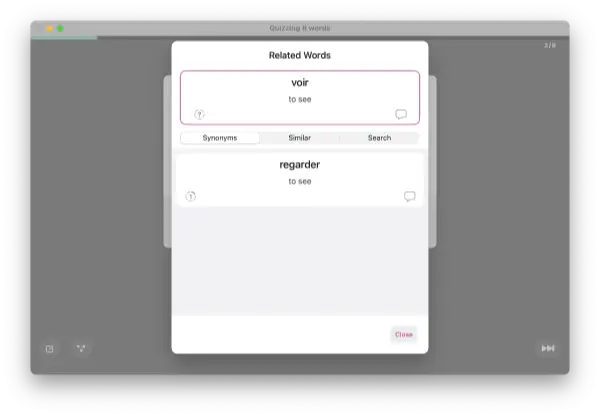Learn related words easier with Wokabulary 7.6
By Julius —
Learning new words works best when we tie them to words we already know. Recent research shows that our brains store language like a web: the more connections a word has, the easier it is to remember and use.

One study published in Nature examined Chinese learners of English. By turning participants’ vocabulary into “semantic networks,” the researchers found that as learners became more proficient, their mental lexicon turned into a densely‑woven web—each word linked to many others. The richer the web of relationships, the easier it is to recall and use new words. (Full paper: The developmental trajectories of L2 lexical-semantic networks).
Another experiment compared two ways of teaching vocabulary. In one condition, new words were presented alone; in the other, they were shown together with related synonyms, opposites, or words from the same category. Participants who saw the related words remembered them better, kept them longer, and could use them in new sentences more easily. (See the study When pumpkin is closer to onion than to squash: The structure of the second language lexicon).
Together, these findings tell us that linking new vocabulary to familiar words creates a richer, more navigable mental map, which in turn speeds up learning and reduces confusion.
Introducing related words in Wokabulary
Wokabulary 7.6 adds a Related Words feature that helps you learn your words in a more connected way. In word‑details view and in the Quiz, you will now find a little network button that brings up the new Related Words sheet. Here you can see all synonyms to a word, as well as all words that are similar to it. You also have a search tab to manually find related words.
This feature especially shines in the quiz as it let you build connections between words while you learn them. Imagine you get asked for the French translation for “to see”. You know there is “voir” but you also remember there is another word for “seeing” that doesn’t come to your mind. In the related words sheet you can now immediately look that up and see that there is also the word “regarder”. Seeing both words together helps you learn them more effectively.

Or say you get asked for the French word for “tour”. That is easy you think and answer with “la tour” only to see that Wokabulary displays the correct answer as “le tour”. The Related Words view now shows you all words similar to “le tour” and you directly see that “la tour” means “tower” and “touriste” means “tourist”. So, you can learn similar and related words in clusters.

The new Related Words feature makes the connections between words visible. It helps you weave a tighter vocabulary network, making new words easier to recall and reducing the chances of confusing similar terms.
Adding Glass
Wokabulary 7.6 also adopts the new Liquid Glass interface language of macOS 26 and iOS 26. The sidebar, toolbar, and prominent buttons now have a glassy background and liquid animations. We have also updated Wokabulary’s app icon to adopt the new glass style and support the new app icon styles like dark mode, glass mode, or tinted mode.
Wokabulary now integrates even better into your Mac, iPhone, iPad, and Apple Watch and with the new icon it looks even cooler on your home screen or in your Dock.